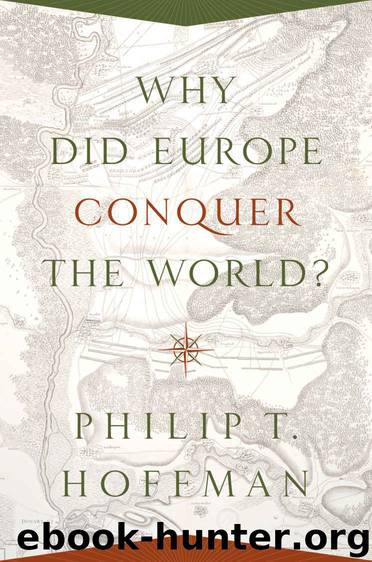Why Did Europe Conquer the World? (The Princeton Economic History of the Western World) by Philip T. Hoffman

Author:Philip T. Hoffman
Language: eng
Format: mobi, azw3
Publisher: Princeton University Press
Published: 2015-06-29T14:00:00+00:00
1 For additional ways in which history influences outcomes, see Greif 2006 and David 1994 for path dependence and the way it allows history to affect institutions.
2 Imperial China did change in size, particularly when it expanded during the Qing Dynasty (1644–1912).
3 There were of course other forces protecting western Europe too—among them, more inviting targets elsewhere in Eurasia and conflict among different nomadic groups.
4 Alesina and Spolaore 2003, especially p. 106. The precise dimensions of such a state would presumably depend on military technology and on the costs of transportation. It might be small when transport costs were high and defense fortifications were effective, as in medieval Europe, and large when defending against nomads. But military technology and transportation costs are themselves affected by state size. A large state is more likely to abut areas vulnerable to attacking nomads, and it can cut transport costs over a wide area by assuring security. Cf. Dudley 1991. Levine and Modica 2013 have a promising evolutionary model of state size; it too tends to hegemony by a large state except when there is an outside threat. Their model would provide another way to reach the conclusions I come to via cultural evolution.
5 Qing Dynasty China measured some 14.7 million square kilometers in 1790, according to Turchin, Adams, et al. 2006. The two biggest countries in western Europe (France and the Austrian Dominions) were under 0.7 million in the late eighteenth century. The comparison leaves aside colonies, which would have made the Spanish Empire even bigger than Qing China. China’s dimensions under the Ming Dynasty were smaller—the Chinese empire measured some 6.5 million square kilometers in 1450—but even so it was still an order of magnitude larger than any contemporary European realm. So were the Ottoman and Mughal Empires.
6 In an era of high transportation costs, it was easier to monitor delegates in a smaller state and therefore easier for smaller states to have representative institutions. In early modern Europe, states with representative institutions could raise more tax revenue per capita, even if we take into account differences in wages, urbanization, and the cost of fighting wars. See Hoffman and Norberg 1994; Dincecco 2009; Stasavage 2010; Dincecco 2011; Stasavage 2011.
7 Kennedy 1987, 16–23; Cosandey 1997; Lang 1997; Diamond 2005, 454–456, 496.
8 Rainfall and river systems may have also played a role. Lang 1997 notes that irrigation and water control favored large states in China. The argument is essentially that a large state can take advantage of economies of scale and internalize externalities in providing the water control infrastructure. But Lang also observes that this advantage cannot be the ultimate explanation for China’s unity, because the infrastructure was locally developed and locally maintained in much of China.
9 Yang 2011. The historian John K. Fairbank reached a similar conclusion (Fairbank 1974, 3) as did the political scientist Hui 2005 in her comparison of warfare and politics during the initial unification of China and the early modern military revolution in Europe.
10 Yang 2011.
11 A measure that Cosandey devised points in the same direction: Cosandey 1997, 299–307.
Download
Why Did Europe Conquer the World? (The Princeton Economic History of the Western World) by Philip T. Hoffman.azw3
This site does not store any files on its server. We only index and link to content provided by other sites. Please contact the content providers to delete copyright contents if any and email us, we'll remove relevant links or contents immediately.
| Anthropology | Archaeology |
| Philosophy | Politics & Government |
| Social Sciences | Sociology |
| Women's Studies |
The Secret History by Donna Tartt(18787)
The Social Justice Warrior Handbook by Lisa De Pasquale(12098)
Thirteen Reasons Why by Jay Asher(8760)
This Is How You Lose Her by Junot Diaz(6722)
Weapons of Math Destruction by Cathy O'Neil(6100)
Zero to One by Peter Thiel(5650)
Beartown by Fredrik Backman(5565)
The Myth of the Strong Leader by Archie Brown(5390)
The Fire Next Time by James Baldwin(5215)
How Democracies Die by Steven Levitsky & Daniel Ziblatt(5105)
Promise Me, Dad by Joe Biden(5049)
Stone's Rules by Roger Stone(5000)
100 Deadly Skills by Clint Emerson(4815)
A Higher Loyalty: Truth, Lies, and Leadership by James Comey(4813)
Rise and Kill First by Ronen Bergman(4669)
Secrecy World by Jake Bernstein(4608)
The David Icke Guide to the Global Conspiracy (and how to end it) by David Icke(4572)
The Farm by Tom Rob Smith(4412)
The Doomsday Machine by Daniel Ellsberg(4386)
